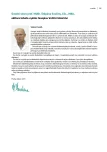Glycation of lens proteins in diabetes and its non-invasive assessment – first experience in the Czech Republic
Authors:
Jan Škrha Jr; Jan Šoupal; Martin Prázný; Jan Škrha
Authors‘ workplace:
III. interní klinika 1. LF UK a VFN Praha, přednosta prof. MUDr. Štěpán Svačina, DrSc., MBA
Published in:
Vnitř Lék 2015; 61(4): 346-350
Category:
Original Contributions
Overview
Advanced glycation end-products (AGEs) play a crucial role in the pathogenesis of diabetes and its complications. Their accumulation in the lens reflects total glycation rate in the human body. Recently, a new confocal biomicroscope ClearPath DS-120 quickly measuring lens autofluorescence (LAF) has been developed. Our pilot study included 69 patients with diabetes and 49 healthy controls, in all subject LAF was measured and compared with skin autofluorescence (SAF) assessed by AGE-Reader. Both LAF (T1DM: 0,27 ± 0,09; T2DM: 0,22 ± 0,06; controls: 0,17 ± 0,04 AU; p < 0,0001) and SAF (T1DM: 2,0 ± 0,4; T2DM: 2,3 ± 0,6; controls: 1,8 ± 0,3 AU; p < 0,0001) was significantly higher in patients with diabetes. In all groups significant relationship between LAF and SAF was observed (T1DM: r = 0,53, p < 0,005, T2DM: r = 0,37, p < 0.05; controls: r = 0,30, p < 0,05). On the contrary, LAF and SAF relationship with glycated hemoglobin (HbA1c) was rather poor, since HbA1c cannot wholly reflect long-term glycation process. Lens autofluorescence could be a robust marker of long-term diabetes control predicting future complication risks. However, confirmation of such hypothesis will need other and long-term clinical studies.
Key words:
advanced glycation end-products – diabetes mellitus – glycation – hyperglycemia – lens autofluorescence – skin autofluorescence
Sources
1. Maillard LC. The action of amino acids on sugar; the formation of melanoidin by a methodic route. Cr Hebd Acad Sci 1912; 154 : 66–68.
2. Ortwerth BJ, Chemoganskiy V, Mossine VV et al. The effect of UVA light on the anaerobic oxidation of ascorbic acid and the glycation of lens proteins. Invest Ophthalmol Vis Sci 2003; 44(7): 3094–3102.
3. Schalkwijk CG, Miyata T. Early - and advanced non-enzymatic glycation in diabetic vascular complications: the search for therapeutics. Amino acids 2012; 42(4): 1193–1204.
4. Boyd AC, Abdel-Wahab YHA, McKillop AM et al. Impaired ability of glycated insulin to regulate plasma glucose and stimulate glucose transport and metabolism in mouse abdominal muscle. Biochim Biophys Acta 2000; 1523(1): 128–134.
5. Gugliucci A. “Blinding” of AMP-dependent kinase by methylglyoxal: A mechanism that allows perpetuation of hepatic insulin resistance? Medical Hypotheses 2009; 73(6): 921–924.
6. Shui YB, Beebe DC. Age-dependent control of lens growth by hypoxia. Invest Ophthalmol Vis Sci 2008; 49(3): 1023–1029.
7. Tomana M, Prchal JT, Garner LC et al. Gas-chromatographic analysis of lens monosaccharides. J Lab Clin Med 1984; 103(1): 137–142.
8. Ahmed MU, Thorpe SR, Baynes JW. Identification of N-epsilon-carboxymethyllysine as a degradation product of fructoselysine in glycated protein. J Biol Chem 1986; 261(11): 4889–4894.
9. Sell DR, Monnier VM. Structure elucidation of a senescence cross-link from human extracellular-matrix – implication of pentoses in the aging process. J Biol Chem 1989; 264(36): 21597–21602.
10. Nagaraj RH, Linetsky M, Stitt AW. The pathogenic role of Maillard reaction in the aging eye. Amino acids 2012; 42(4): 1205–1220.
11. Monnier VM, Sun WJ, Sell DR et al. Glucosepane: a poorly understood advanced glycation end product of growing importance for diabetes and its complications. Clin Chem Lab Med 2014; 52(1): 21–32.
12. Vannas MWA. Eine Methode zur Meesung der Fluorenzenz (lor lehnden menschlichen Augenlinse und eine Untersuchung über ihre Abhängigkeit). Alter Klin Monatabl Augenh 1938; 95 : 53–64.
13. Klang G. Measurements and studies of the fluorescence of the human lens in vivo. Acta ophthalmologica 1948; 31 : 1–152.
14. Bleeker JC, Vanbest JA, Vrij L et al. Autofluorescence of the lens in diabetic and healthy-subjects by fluorophotometry. Invest Ophthalmol Vis Sci 1986; 27(5): 791–794.
15. Abiko T, Abiko A, Ishiko S et al. Relationship between autofluorescence and advanced glycation end products in diabetic lenses. Exp Eye Res 1999; 68(3): 361–366.
16. Skrha J, Soupal J, Ekali GL et al. Skin Autofluorescence Relates to Soluble Receptor for Advanced Glycation End-Products and Albuminuria in Diabetes Mellitus. J Diab Res 2013, 2013 : 650694. Dostupné z DOI: <http://dx.doi.org/10.1155/2013/650694>.
17. Burd J, Lum S, Cahn F et al. Simultaneous noninvasive clinical measurement of lens autofluorescence and rayleigh scattering using a fluorescence biomicroscope. J Diabetes Sci Technol 2012; 6(6): 1251–1259.
18. Mulder DJ, Water TV, Lutgers HL et al. Skin autofluorescence, a novel marker for glycemic and oxidative stress-derived advanced glycation endproducts: an overview of current clinical studies, evidence, and limitations. Diabetes Technol Ther 2006; 8(5): 523–535.
19. Meerwaldt R, Graaff R, Oomen PHN et al. Simple non-invasive assessment of advanced glycation endproduct accumulation. Diabetologia 2004; 47(7): 1324–1330.
20. Januszewski AS, Sachithanandan N, Karschimkus C et al. Non-invasive measures of tissue autofluorescence are increased in Type 1 diabetes complications and correlate with a non-invasive measure of vascular dysfunction. Diabet Med 2012; 29(6): 726–733.
Labels
Diabetology Endocrinology Internal medicineArticle was published in
Internal Medicine

2015 Issue 4
Most read in this issue
- Myokines – muscle tissue hormones
- The treatment of diabetes in patients with liver and renal impairment
- Treatment of GLP1 receptor agonists and body mass control
- Treatment of hypertension in diabetes mellitus
